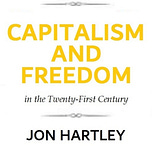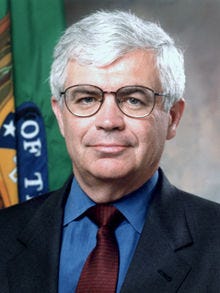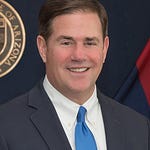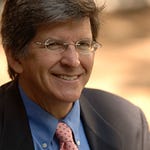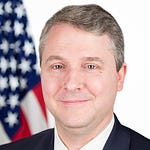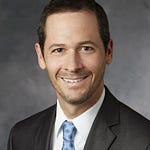John Taylor, the Mary and Robert Raymond Professor of Economics at Stanford University and Senior Fellow at the Hoover Institution, joins the podcast to discuss how he initial got interested in economics, his initial training in econometrics as a PhD student at Stanford which led him to monetary economics, his seminal contributions to the foundations of New Keynesian economics including the Taylor Rule and its influence, his views on monetary policy in the US, Europe and Japan over the decades, international economics, the state of fiscal policy, and economic growth.
Jon: “This is the Capitalism and Freedom in the 21st Century podcast, where we talk about economics, markets, and public policy. I'm John Hartley, your host. Today, I'm joined by John Taylor, who's the Mary and Robert Raymond Professor of Economics at Stanford University. John is also a senior fellow at the Hoover Institution and is one of the world's greatest living monetary economists. John is also the inventor of the Taylor Rule, which is a canonical description of how central banks change interest rates in response to inflation and output gaps. He is also one of the founders of the New Keynesian macroeconomic paradigm and is consistently cited as a likely future winner of the Nobel Prize in Economics, which I think would be more than well-deserved. John has also served in many positions in government. He has served in the U.S. Navy. He's also served in the White House Council of Economic Advisers, and he's served as the U.S. Treasury Undersecretary of International Affairs during the George W. Bush administration. Welcome, John.”
John: “Good to be here. Thank you.”
Jon: “You were born in Yonkers, New York. You're a Princeton undergrad. You're a Stanford PhD. How did you get interested in economics in the first place, and what influenced you to get into the field of monetary economics? Well, I majored in economics in college, went to Princeton, and had some advisors, Bill Howey, for example, who just encouraged looking at the overall macroeconomy, and that interested me from the start. And not so much that that's what I was going to do, but I did my regular senior thesis and did my senior thesis.”
Jon: “It was required at Princeton.”
John: “It was required, yes, required. And so, I did it in that particular topic, and that's what got me interested. And I went to graduate school at Stanford after that. Actually, I had a little interruption in the Navy, went to the Navy, and between Princeton and coming out here, which was formative, to be sure, and then came back here. And I was interested in econometrics, actually, from—Ted Anderson was my advisor. He's passed away. He's a great advisor. And I did econometrics, but that was more on my way to study monetary. I never really lost the interest in monetary economics and how you could smooth the business cycle, how you could have a better economic policy.”
Jon: “Fantastic. And I'm curious, like, so you've been a professor at Stanford for some time. I'm curious, like, how did some of these collaborations, for example, in the early New Keynesian days, folks like Ned Phelps, for example, I think, you know, one of the biggest, I think, contributions, I think, that you made to the New Keynesian literature was, you know, coming up with this idea of having a monetary policy rule, or, you know, would later be named the Taylor rule. And initially, it was sort of used as this third equation to allow for the determinacy of equilibrium. And it turned out, I think, later, a great description of the world and how the Fed actually would follow monetary policy when it would follow interest rate targets and prescription for optimal policy later. But I'm curious, like, how did you get interested in this idea of central banks should be following interest rate targets instead of, you know, just say money growth rule targets, you know, things that, you know, obviously, Milton Friedman was a big fan and proponent of and certainly captured a lot of the Fed's interest in the 1970s and 80s. How did you fall into this sort of conversation about following interest rate targets, and how did that interest you in the early New Keynesian days?”
John: “Well, it came very gradually. It was originally built and was interested in econometric models. They were quite elaborate. They did have this mixture of expectations and sticky prices, which I thought was very important. And that was a way to both have the ability to affect expectations of future prices, but also have some rigidities, which still seems to me an important aspect of the economy. So, it was a basic structure, which was fundamental. But in that context, you have to have a model of policy. And, of course, Milton Friedman was a great influence in the idea of having a money growth rule. Having a rule is essential. How do you study policy without some kind of notion of what the central bank is going to do next year, next quarter? Because expectations are so important. You have to build on expectations. And you build them in by somehow having a description of what the central bank will do.”
Jon: “Something that Sargent and Lucas sort of brought in.”
John: “I'm sorry?”
Jon: “Something that Sargent and Lucas in the rational expectations macro-binding models sort of came in in the 1980s.”
John: “Yeah, in some sense, they never had sticky prices. That was the huge difference. They had perfectly flexible prices. And so, what I thought was important, based on my studies and looking at the world, was to have some kind of rigidity, but not permits. Something that could be influenced by policy, you could do it. So that's why a rule became important, a strategy for the central bank became important. And I really began to look at that, but it's gradual over time. You know, you had to have some stipulation of what the central bank was going to do, what the fiscal policy was going to do. Otherwise, how would you have a model if you didn't have some description? So early on, there was a description, and that gradually evolved to some description where the primary variable, which the central bank had influence on, was the interest rate. And that affected the money supply. We always had a money demand function in these models. That was still a very important part of it. But I thought, based on my experience in Washington, I worked on the CEA a couple times, and you could see, and became good friends with the policymakers, you could see that their focus was more on interest rates. So, I wanted to find a way to do that, but to preserve the notion of a policy rule, of a strategy, that the central bank was consuming. So, it was a gradual thing over time, but it involved research and academia, and then getting my PhD, of course, but going to work in the Council of Economic Advisers in Washington, coming back and doing more work, and going back again. That mixture back and forth was very important. I had four cents in the government and a couple in the government.”
Jon: “But that's fantastic. I want to get back to that a little bit later when talking about the fiscal outlook. But speaking to monetary policy, just for a second here, how exactly did the Taylor rule come about? Obviously, your famous 1993 paper, the Discretion Versus Policy Rules and Practice, famously has a coefficient of, I think, 0.5 on the output gap and 1.5 on inflation, which I think became, I think, your most cited paper. It's been an incredible description of the world and something that central banks all over the world pay attention to closely when thinking about what monetary policy should be, even if perhaps they don't follow it as closely as they should at times. How did this idea come about to write that 1993 paper?”
John: “Well, it wasn't easy. It took a while. By the way, it's 30 years old as we speak.”
Jon: “Yeah.”
John: “Originally, it didn't set out to write simple. But if you had a—you looked at policy. It was complicated. And there wasn't a way we could make it simpler. And that was what I strived for. I didn't know it would become as useful or as popular as it's become globally. It's well known. It was mainly a method to simplify in a way that people could understand. You could talk about it. As you say, the coefficients, 1.5 and 0.5, look a bit simpler than that. Just two variables, the inflation rate and the GDP gap, so to speak. And that was the—it was looking around. I didn't start there, for sure. I had more complicated things. But that seemed to work pretty well in the models. Remember, I came about this through the models first. Make sure that your policy was going to work in the model. And you had a criterion. You wanted to have a low inflation rate, around 2% or so. That was the goal. That was the 2% target. I think it was the first time maybe one of the central banks had 2% before then. But they had a simple—sometimes they thought maybe 1.5 would be better. 1 would be better. Just choose an easy number. And then work from there. Originally, it was more complicated things. The exchange rate was certainly a factor that people talked about, so I considered that. But I just realized you'd come pretty close to an optimal policy, pretty close to the more complicated thing, which had 30 variables or 10 variables on the right-hand side. You had two. And that was kind of an eye-opener for me. But I still thought it was something that wouldn't have as much impact as it has.”
Jon: “Well, it's amazing. I feel like it's like one of those strokes of brains and genius that you look back on it now 30 years later, and it's like, well, isn't that obvious that that followed unemployment, inflation, part of the dual mandate? But I think it's one of the things where it was probably not at all obvious at the time that the Fed could follow these things so closely in the way that you wrote down the Taylor rule and something that obviously influenced central banks around the world. Now, I want to sort of get in a little bit to this question of optimal policy. I think this is where I think there's a lot of maybe confusion about and sometimes criticism about the Taylor rules being something that, you know, is too rigid to follow mechanically and where I think people say things like, oh, we shouldn't adopt the Taylor rule. I think that the irony is that central banks around the world have already adopted Taylor rules. And you can just see that in the data. But I think one sort of misconception is that you advocate for something that's strictly mechanical. If you look to, for example, things like the Federal Oversight and Reform Act from 2016, something which you had direct influence on and was something that was put forward by Congress, I think that stipulated that Congress could revise these rules. That there wouldn't necessarily be such a mechanical thing. I'm curious, like, how has your time in Washington, when you visit, talking with Congress people and talking with monetary policy makers, I mean, how do you respond to those sorts of critics who argue that, you know, that monetary policy should be not somewhat rules-based in a sense?”
John: “Well, let me say, the idea of a rules-based policy has always been very important. In other words, how are you going to figure out what the central bank is going to do next year without some kind of a description of what they did? So, the notion of a rule, whether it's simple or complicated, is essential to what I was always interested in way back at the very beginning. And the idea that, well, it's too complicated, there are five variables, came from working in Washington, knowing people at the Fed, knowing Dean Spann. He was the chair of the CEA for a while. And so, you got the sense a little of what they were thinking about and how you could simplify it. And clearly, you had some notion of inflation. If you had a target inflation rate of 2%, then you had some sense to tighten policy when inflation got too high, to ease policy when inflation got too low. So that became a key ingredient. But you also noticed that, well, the central bank also looks at the state of the economy. What's the unemployment rate? What's the GDP gap? And so, you had to have something in that. And that wouldn't make sense if you didn't, because the Fed is going to ease when the economy is in a tough time. And then there's other variables that you want to include, too. As I mentioned, the exchange rate was very common, especially for economies where international trade and foreign exchange are very important. So, I definitely considered that a lot. But the idea, I guess, was you had to have something similar. And I knew that from working in Washington several times and knowing central bankers in the U.S. and other places. And that's where the idea of, as you say, simple. And people always argue it's too simple. How can policy be so simple? It's two variables. But it turned out to be pretty good. By the way, it's not always. Sometimes they get off. And I think the Fed recently has been off. Now they're back on again, closer at least. And so, people are looking back at what was wrong, and they were so far off. And maybe that's a problem. Maybe that will bring even more attention back to some kind of a simple rule. I've noticed a lot of interest. And you mentioned the Congress having quite a bit of interest in this. And there was some legislation passed. The Fed had to say what its rule was. And the Congress had built into their testimony. But that faded away. I don't know. Maybe if we're back now, people will see how useful it actually is. Something off that, I want to touch just a little bit about the Taylor principle. This idea that the Fed needs to raise short-term interest rates more than one for one with inflation. This goes back to the Taylor rule coefficient of 1.5 on inflation. There's certainly been this experiment that's been playing out, and others like John Cochran have written a bit about this. There's a question about neo-fascism and so forth. And that is, like, we're in this era of inflation sort of maybe peaked at 8% or so, and it's still at 6%. Do we actually need to raise the Fed funds rate to above inflation to get it to come down? And it increasingly seems like that's the case, and interest rates are, as of this moment, around 5%. I'm curious, what are your thoughts on that debate right now and where monetary policy currently is? Do you think the Fed has been too slow to respond to inflation that picked up in May of 2021 and became certainly more than just a temporary phenomenon as it became increasingly clear over time? How do you think the Fed has been? How would you assess the Fed's response to this early 2020s inflation?”
John: “Well, yeah, it was quite slow. In fact, we did a book on the desk here on how monetary policy got behind the curve, which was a really important thing.”
Jon: “And this is the summary of your monetary policy and other proceedings from last year.”
John: “A lot of people contributed to this, but they were behind. There's no question the interest rate was sliding by basis points and the rules would say it should be 4 or 5 or something like that. So, they have quite a way to catch up, and they're now 1.5 or so. But I still think, based on the ruling, it ought to go a little higher. And you can say, why 1.5? The idea is to have the real interest rate a little bit higher than normal so that would offset the other impacts of keeping inflation from high, basically to attenuate it. It's also very important that this be known. As long as it's known, the impacts are much less severe. The worst thing is a surprise [Inaudible 16:03]. The whole idea of a rule or a strategy is that people know what it is. And it's also important internationally, so the U.S. knows what's happening in Japan or Europe, and so they have a sense of what's going on there. So, I think, ultimately, this is always meant to be an international aspect. That's why I'm always worried about the exchange rate, but it seems like the U.S. exchange rate is less important. And also, let me say this. It's very important to say. I originally said, this is a guideline. Don't follow this exactly. There's other things that come into play. Oh, if you go back and read this five-thirty-year-old paper or whatever it is, you can see that pretty clear. Now it's become more adopted, more descriptive of what actually happens, as you say. And that's become an important way to test it. Now we know how other central banks are doing and what they don't. They didn't follow this method in the 70s, and inflation went through the roof. And then they've been better at it. We'll see what happens now. There's a real question about what's happening in monetary policy right now.”
Jon: “Absolutely. I want to jump a little bit to fiscal policy and to get your thoughts on that. You've long spoken about fiscal issues in the U.S. You testified on these issues and you've written several papers and books on this topic. You also served as Undersecretary for International Affairs. You ran OIA, or Office of International Affairs, at the Treasury in the early 2000s. You spent time at the E.A. and you worked. And you also served in the military. So, you've seen the government spending side at work very up close as well. I'm curious, what do you think about the long-term fiscal outlook for the U.S.? This COVID-era spending has piled on an additional four-plus trillion dollars in spending. There's, right now, some negotiations in D.C. about raising the debt limit. I think it's something that seems to get lifted every few years. About ten years ago, there was this big discussion around Bowles-Simpson, the Bowles-Simpson Commission. There were a lot of discussions about debt then. Debt seems to have become a bygone era almost at this point. With, I think, very few politicians in both parties wanting to talk about the reality of entitlement spending and the future path of debt. We also have inflation and interest rates, which obviously influence the net interest rate, the net interest cost. I’m curious, what do you think about the fiscal outlook for the U.S., and what do you think needs to be done?”
John: “First of all, I think we talked about monetary policy. That's where the Cato and things like that come from, because I thought it was so important to have something that was better than a fixed-money growth rule, but had the same principles of the rule. But there's other rules. There's fiscal rules. There's rules for regulation. There's international rules. I always have written about this is just one element of good policy. You have to have a good fiscal policy, have a good regulatory policy, a good international policy. So fiscal policy is a very important part of this. And I think that, originally, the notion is you had a balanced budget, normal times, and you had surpluses and deficits around that. But we're far from that at this point. And I think it would be easier for monetary policy, it would be easier for policy all around if fiscal policy also had this notion of a smaller deficit. And the deficit isn't quite big. And to some extent, it's really like monetary policy being off. They're both off. But I think that the more we can come back to the basic elements of what good economic policy is, and rules-based is part of it, and you have a fiscal rule, it really makes a difference. So, there's lots of problems with big deficits. Sometimes they're like the panic we had a few years ago. You had to have it. It's there already. The interest rate's driven near to zero. But the idea is, in normal times, you don't need that, and you should get out of it. So, I would like to see policy, fiscal policy, as well as monetary policy, get back to a more normal stance. I think policy would work better if that was the case. And there's also international aspects of fiscal policy, too.”
Jon: “Absolutely. I mean, it's interesting to see Europe, obviously, is trying to adopt fiscal rules and trying to get its fiscal house in order. On the international side of things, do you have any particular thoughts about the sort of European experiment with the euro and having a monetary union but not a fiscal union?”
John: “Well, I think that their decision to have a single currency was a good one. They had reign in certain countries and have a sort of a common policy as well. It’s hard to do but I think that led to good policy. I think they are little off right now to be sure. I think it’s a good system, UK is not part of it and so and also, I think that’s a good way to think about how the world will work. These are countries that are quite different, Italy and Germany, for example. But the idea of bringing them together with a common framework always seemed to me to be good. And, you know, whether it's a Taylor rule or some other kind of rule, that is part of their thinking. It's always a part of their thinking. And there's influence that they all know about that. So, I think it's a good phenomenon that's happening, a good trend that's happening. But it's not the only answer, because you still have to deal with differences of opinion, different cultures, different nationalities.”
Jon: “Any thoughts on Japan? Japan being one of the first countries to embark on quantitative easing. We've seen this whole decade of quantitative easing; I feel like the 2010s. The monetary policy response was largely embracing this sort of unidimensional form of monetary policy, buying in long-term bonds, trying to bring down long-term bond yields. What do you think the legacy of that has been? And do you have any particular thoughts on Japan? [Inaudible 22:20]”
John: “Yeah, it's a very important part of the world economy. I spent several months at the Bank of Japan learning how they work and talking with the policymakers. I think they have a new government committee and that will change things. I think it will get back to a more rules-based policy, we'll see.”
Jon: “There's Kuroda leaping, he's just retiring. I think Kuroda is exiting this month. “
John: “Yeah, they mean well, they're good people. But I think they have lost track of how to conduct monetary policy. We'll see if it comes back a little bit. But it's a different country, different policies that are taken throughout, and so you have to put that in the right context. But it's important, I think what's important now is how do you have a global system where each central bank, so many central banks in each country that are independent, are conducting policy in a way that's good for their economy, but it's also good for the world economy. And that's what I think, that's what I hope will happen in the next few years. We've had a lot of progress, we're not there yet, that's for sure. And I think, as you say, it's fused, some people think it's too simple, some people think we need to do more complicated things. What's amazing is you don't have to be that complicated; it works pretty well. That's what the evidence has shown. It's been 50 years since Bretton Woods and we've been in this flexible exchange rate regime for some time. Any thoughts on... This was obviously a big debate that Friedman had with Mundell. Friedman definitely won the flexible exchange rates fight when, 50 years ago, the pegs were broken. But certainly, I think Mundell was able to get his euro brainchild in place and a common currency in the euro, and obviously that's been very controversial. I'm curious what you think of the legacy of flexible exchange rates that we all have today.”
John: “Milton Friedman was a good friend. He was here at Stanford for quite a few years and talked a lot about policy rules, that's for sure. He knew about the Taylor Rule very well. We talked a lot about that. We talked about the fixed money growth rule. The idea of having a flexible exchange rate, that's in the Taylor Rule. Unless you somehow get together and have one central bank, so you have the same interest rate, I can hear it. But it was definitely a way, how could you realize exchange rate is going to be flexible and still have a policy rule? And I think that's the fixed money growth rules of Milton Friedman were very much that way. And so, so is the Taylor Rule. There's no exchange rate explicitly. And that was, as they say, I worry a lot about that. What about the exchange rate? And it turned out to be pretty simple. In fact, the inflation rate and GDP gap in the interest rate is pretty close to the money growth rule. And you look at the interest rate specifically rather than let the interest rate come out of the policy. We have fixed money growth. Fixed money growth implies interest rate. This way, the interest rate is decided and it implies the money growth rate. So, the idea of a rule is very, very clear. That's, as long as I've been in economics, I would think about rules for strategies, for monetary policy and fiscal policy. Don't get you asking about how I got interested. Well, there were rules. They were more complicated. But how could you make it simpler? And then I think that was where working in Washington and understanding and getting to know the policymakers, getting to know members of Congress, getting to know the White House and how the president was working with other people, you began to see something simpler was going to be important to this. It's just, you don't want it to be so complicated. There's no reason for it to be so complicated.”
Jon: “Absolutely. Absolutely. You think about Taylor Rule and then open economy, Mundell Fleming says, if you're going to have a monetary policy where you can change interest rates and not have a paid interest rate permanently, you have to allow for both movement of capital flows and to have free flow and exchange rates. I'm curious, going back just on a final note here, part of your time in Washington, you were Undersecretary for International Affairs. Part of that was not just focusing on the developed economies in the developed world, but also on emerging economies in many other parts of the world, the developing parts of the world. I know you spent some time helping to set up currencies in Afghanistan and Iraq in the early 2000s. I'm just curious about your thoughts on global economic growth and your thoughts on regulation institutions. I'm sure you had many great conversations with Milton Friedman. I spent a lot of my time researching on things that relate to economic growth and constraints on economic growth. I'm curious, what is your broad thinking about, what is the secret sauce to economic growth in the economy?”
John: “I go back to the notion of the economic policy, it's monetary policy, fiscal policy, regulatory policy. in some international respect. There seems to be... I've written books about that. That's the most important thing to keep in place. So monetary policy is very important, but countries are different. Maybe fixed money growth will work best for a small economy in Africa. And so, you have to recognize the institutions are different, and I've always emphasized that. I think what I've seen over the very recent years, and the experience with countries, is that this kind of rule where the interest rate is the main variable, they could be countries coming together in a union of some kind, like the European Central Bank and the monetary union. But the notion that there'd be some stable, understandable monetary policy is key. Because, you know, think about how terrible it could be if you don't think of Zimbabwe. You know, I carry Zimbabwe notes on my wall to show kids how bad it can be. And it can be really terrible. And we still have that problem around. And there's other things that interfere with monetary policy. But just focusing on monetary policy, there's a lot that can be done in Africa, Asia, Latin America. Latin America still has high inflation rates. What's going on? They don't need to have that. But there's still a feeling that, well, maybe high inflations not so bad. In fact, right now, there's people saying, well, why have a 2% inflation? Well, we have 3%, 4%. And so, I don't think that's a good idea. I just last week in Congress emphasized that 2% is where we are. Many countries have that. There's a sense that that causes more stability than it is. One has 4%, one has 10%, one has 2%. And so, I think try to stick with that. And there's always temptation. Hey, well, if we were some 4%, we could get to that. But it is a big deal. And that is a unifying theme that I hope we continue with in the future.”
Jon: “Well, it's fascinating. I know there's been some discussions about potentially a monetary union between Argentina and Brazil. I don't know if that will happen or if that's a good deal for the Brazilians. But I know that there is a good chunk of evidence that there's resurgent economic growth and maybe some evidence that there's some convergence across the developing world. And I think this is really just in the past two decades. And I think it's fair to say that a lot of that, I think, is partially in thanks to monetary stability. And I think a lot of that goes back to so much of the great work that you've done over the past decades. And I know many are still fascinated by all of your work, John. I want to thank you so much for joining us today, John. It's been a real pleasure having you.”
John: “It's been great. Thanks for your great questions. It's terrific. I enjoyed it.”
Jon: “Today, our guest was John Taylor, who is the Mary and Robert Raymond Professor of Economics at Stanford University and is a senior fellow at the Hoover Institution. This is the Capitalism and Freedom in the 21st Century podcast, where we talk about economics, markets, and public policy. I'm John Hartley, your host. Thanks so much for joining us.”


